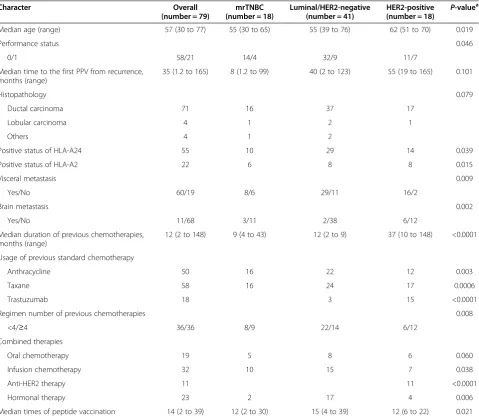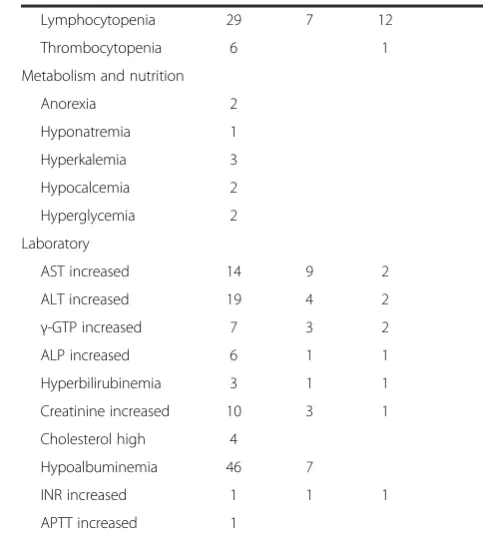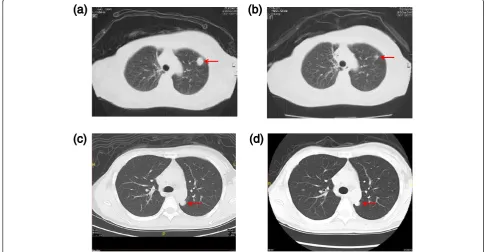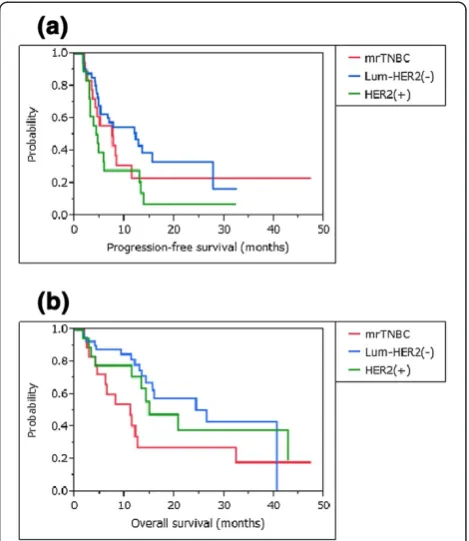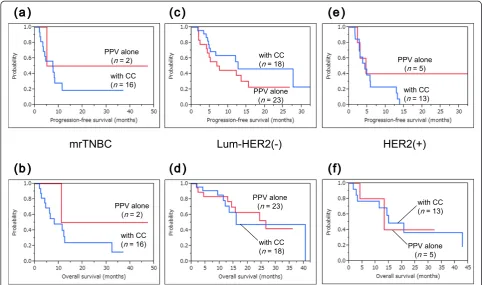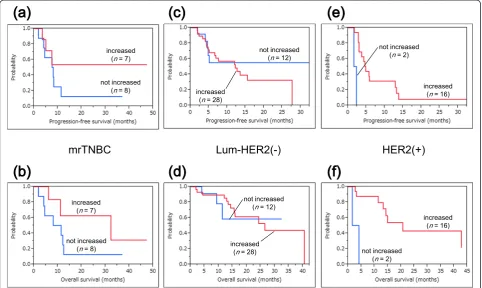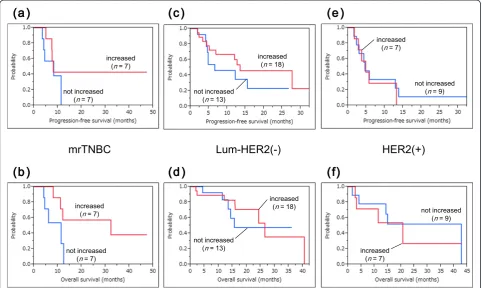vaccination for metastatic recurrent triple-negative
breast cancer patients
Takahashi
et al.
R E S E A R C H A R T I C L E
Open Access
Feasibility study of personalized peptide
vaccination for metastatic recurrent triple-negative
breast cancer patients
Ryuji Takahashi
1*, Uhi Toh
1*, Nobutaka Iwakuma
1, Miki Takenaka
1, Hiroko Otsuka
1, Mina Furukawa
1, Teruhiko Fujii
2,
Naoko Seki
2, Akihiko Kawahara
3, Masayoshi Kage
3, Satoko Matsueda
4, Yoshito Akagi
1, Akira Yamada
2, Kyogo Itoh
4and Tetsuro Sasada
4Abstract
Introduction:Since treatment modalities for metastatic recurrent triple-negative breast cancer (mrTNBC) are limited, a novel treatment approach including immunotherapy is required. We have developed a novel regimen of personalized peptide vaccination (PPV), in which vaccine antigens are individually selected from a pool of different peptide candidates based on the pre-existing host immunity. Herein we conducted a phase II study of PPV for metastatic recurrent breast cancer patients to investigate the feasibility of PPV for mrTNBC.
Methods:Seventy-nine patients with metastatic recurrent breast cancer who had metastases and had failed standard chemotherapy and/or hormonal therapy were enrolled. They were subgrouped as the mrTNBC group (n = 18), the luminal/human epidermal growth factor receptor 2 (HER2)-negative group (n = 41) and the HER2-positive group (n = 18), while the remaining two patients had not been investigated. A maximum of four human leukocyte antigen (HLA)-matched peptides showing higher peptide-specific immunoglobulin G (IgG) responses in pre-vaccination plasma were selected from 31 pooled peptide candidates applicable for the four HLA-IA phenotypes (HLA-A2, -A24, or -A26 types, or HLA-A3 supertypes), and were subcutaneously administered weekly for 6 weeks and bi-weekly thereafter. Measurement of peptide-specific cytotoxic T lymphocyte (CTL) and IgG responses along with other laboratory analyses were conducted before and after vaccination.
Results: No severe adverse events associated with PPV were observed in any of the enrolled patients. Boosting of CTL and/or IgG responses was observed in most of the patients after vaccination, irrespective of the breast cancer subtypes. There were three complete response cases (1 mrTNBC and 2 luminal/HER2-negative types) and six partial response cases (1 mrTNBC and 5 luminal/HER2-negative types). The median progression-free survival time and median overall survival time of mrTNBC patients were 7.5 and 11.1 months, while those of luminal/HER2-negative patients were 12.2 and 26.5 months, and those of HER2-positive patients were 4.5 and 14.9 months, respectively.
Conclusions:PPV could be feasible for mrTNBC patients because of the safety, immune responses, and possible clinical benefits.
Clinical Trial Registration Number:UMIN000001844 (Registration Date: April 5, 2009)
* Correspondence:takahashi_ryuuji@med.kurume-u.ac.jp;
utoh@med.kurume-u.ac.jp
1
Department of Surgery, Kurume University School of Medicine, 67 Asahi-machi, Kurume 830-0011, Japan
Full list of author information is available at the end of the article
Introduction
Recent advances in chemotherapies, hormonal therapies and anti-human epidermal growth factor receptor 2 (HER2) therapies have significantly improved the prog-nosis in metastatic recurrent breast cancer patients. For example, new chemotherapies using agents such as nanoparticle albumin-bound paclitaxel (nab-PTX) [1,2], eribulin mesylate [3,4] and bevacizumab [5-7], new hormonal therapies such as fluvestrant injection [8,9] or new anti-HER2 therapies such as those using pertuzumab [10,11] and trastuzumab emtansine (T-DM1) [12] have shown significant clinical benefits in metastatic recurrent breast cancer patients. Despite these novel therapeutic advances, the treatment modalities for chemotherapy-resistant triple-negative breast cancer (TNBC) remain limited, and thus a novel treatment approach including immunotherapy is required. Nevertheless, no randomized controlled trials of cancer vaccine have shown promise of clinical benefit for metastatic recurrent breast cancer patients, particularly in metastatic recurrent TNBC (mrTNBC).
We have developed a novel regimen of personalized peptide vaccination (PPV), in which vaccine antigens are selected from a pool of 31 different peptide candidates based on the pre-existing immunoglobulin G (IgG) respon-ses specific to each peptide before vaccination [13-17]. Most of the peptides employed for PPV, except for those derived from prostate-related antigens, are known to be commonly expressed in various types of advanced cancers. Our previous clinical trials of PPV for patients with ad-vanced cancers demonstrated the safety and feasibility of this new approach [13-17]. Here we conducted a phase II study of PPV for metastatic recurrent breast cancer to investigate the feasibility of PPV for mrTNBC.
Methods
Patients and methods
Women with a histological diagnosis of metastatic recur-rent breast cancer were eligible for inclusion in the present study. All patients were required to have evaluable recurrent and/or metastatic tumors at the time of entry. Patients were divided into three different intrinsic sub-types as follows: luminal (estrogen-receptor-positive)/ HER2-negative type, HER2-positive type (immunohisto-chemical score 3+ or HER2 gene/chromosome 17 ratio >2.2 in fluorescence in situ hybridization) and TNBC (hormone-receptor-negative and HER2-negative). Most patients had failed standard chemotherapy, but a few patients who had failed hormonal therapy alone were also eligible for this study. All patients were required to show positive IgG responses to at least 2 of the 31 different vaccine candidate peptides, as reported previously [13-17]. Other inclusion criteria were as follows: age between 20 and 80 years; an Eastern Cooperative Oncology
Group (ECOG) performance status of 0 or 1; positive sta-tus for human leukocyte antigen (HLA)-A2, -A24 or -A26 types, or HLA-A3 supertypes (A3, A11, A31 or A33); life expectancy of at least 12 weeks; and adequate hematologic, hepatic and renal function. Exclusion criteria included pulmonary, cardiac or other systemic diseases; an acute infection; a history of severe allergic reactions; pregnancy or nursing; and other inappropriate conditions for enroll-ment as judged by clinicians. Patients with a lymphocyte count of <1,000/μL were excluded from the study, since we previously reported that pre-vaccination lymphocyto-penia (<1,000 cells/μL) is an unfavorable factor for overall survival (OS) in cancer patients receiving PPV [17]. The protocol was approved by the Kurume University Ethical Committee and registered in the UMIN Clinical Trials Registry (Registration, number UMIN000001844; Regis-tration date, 5 April 2009). All patients were given a full explanation of the protocol and provided their informed consent before enrollment.
Clinical protocol
This was a phase II study to evaluate the safety and immunological responses in metastatic recurrent breast cancer patients under PPV. Thirty-one peptides, whose safety and immunological effects for other types of cancer were confirmed in previously conducted clinical studies [14-17], were employed for vaccination (12 peptides for HLA-A2, 16 peptides for HLA-A24, 9 peptides for HLA-A3 supertypes (-A3, -A11, -A31, and -A33) and 4 peptides for HLA-A26) (Additional file 1: Table S1). These peptides were prepared under the conditions of Good Manufacturing Practice (GMP) by the PolyPeptide La-boratories (San Diego, CA, USA) and American Peptide Company (Vista, CA, USA). Peptides for vaccination of individual patients were selected in consideration of the pre-existing host immunity before vaccination, as assessed by the titers of IgG specific to each of the 31 different vaccine candidates.
such as chemotherapy, hormonal therapy, anti-HER2 therapy and radiotherapy. Adverse events were monitored according to the National Cancer Institute Common Terminology Criteria for Adverse Events version 3.0 (NCI-CTC Ver.-3.0). Complete blood counts and serum biochemistry tests were performed after every six vacci-nations. The clinical responses were determined by the Response Evaluation Criteria in Solid Tumors (RECIST) in the vaccinated patients. The RECIST-based clinical responses were evaluated after nearly 12 vaccinations by radiological findings of computed tomography (CT) scan and/or magnetic resonance imaging (MRI), and the best overall responses during PPV treatment were shown. For the patients who did not complete the second cycle of 12 vaccinations, the newest radiological findings
were evaluated, except in the case of patients who had died before the RECIST-based radiological evaluation.
[image:4.595.59.539.297.713.2]Measurement of humoral and cellular immune responses Humoral immune responses specific to each of the 31 pep-tide candidates were determined by peppep-tide-specific IgG levels using the Luminex system (Luminex, Austin, TX, USA), as previously reported [18]. If the titers of peptide-specific IgG to at least one of the vaccinated peptides in the post-vaccination plasma were more than two-fold higher than those in the pre-vaccination plasma, the changes were considered to be significant, as previously reported [14-17]. Cellular immune responses specific to the vaccinated pep-tides were evaluated by interferon (INF)-γELISPOT using peripheral blood mononuclear cells (PBMCs) as previously
Table 1 Comparison of patient characteristics for overall and breast cancer subtypes
Character Overall
(number = 79)
mrTNBC (number = 18)
Luminal/HER2-negative (number = 41)
HER2-positive (number = 18) P
-valuea
Median age (range) 57 (30 to 77) 55 (30 to 65) 55 (39 to 76) 62 (51 to 70) 0.019
Performance status 0.046
0/1 58/21 14/4 32/9 11/7
Median time to the first PPV from recurrence, months (range)
35 (1.2 to 165) 8 (1.2 to 99) 40 (2 to 123) 55 (19 to 165) 0.101
Histopathology 0.079
Ductal carcinoma 71 16 37 17
Lobular carcinoma 4 1 2 1
Others 4 1 2
Positive status of HLA-A24 55 10 29 14 0.039
Positive status of HLA-A2 22 6 8 8 0.015
Visceral metastasis 0.009
Yes/No 60/19 8/6 29/11 16/2
Brain metastasis 0.002
Yes/No 11/68 3/11 2/38 6/12
Median duration of previous chemotherapies, months (range)
12 (2 to 148) 9 (4 to 43) 12 (2 to 9) 37 (10 to 148) <0.0001
Usage of previous standard chemotherapy
Anthracycline 50 16 22 12 0.003
Taxane 58 16 24 17 0.0006
Trastuzumab 18 3 15 <0.0001
Regimen number of previous chemotherapies 0.008
<4/≥4 36/36 8/9 22/14 6/12
Combined therapies
Oral chemotherapy 19 5 8 6 0.060
Infusion chemotherapy 32 10 15 7 0.038
Anti-HER2 therapy 11 11 <0.0001
Hormonal therapy 23 2 17 4 0.006
Median times of peptide vaccination 14 (2 to 39) 12 (2 to 30) 15 (4 to 39) 12 (6 to 22) 0.021
a
reported [14-17]. As a control, cellular immune responses specific to CEF peptides (MABTECH, Cincinnati, OH, USA), a mixture of virus-derived cytotoxic T lymphocyte (CTL) epitopes, were also examined.
Statistical analyses
The Mann-Whitney U test and Fisher-Freeman-Halton exact test were used to examine statistical differences for continuous values and categorical values, respectively. P-values less than 0.05 were considered to be statistically significant. Progression-free survival (PFS) or OS was cal-culated from the date of the first vaccination until the date of disease progression or death, respectively, or the last date when the patient was known to be alive. The survival analysis was performed using the Kaplan-Meier method, and a comparison of the survival curves was performed with the log-rank test. Statistical tests were performed using JMP version 10 (SAS Institute Inc., Cary, NC, USA) and StatXact version 8 (Cytel Inc., Cambridge, MA, USA).
Results
Patient characteristics
[image:5.595.294.536.100.368.2] [image:5.595.62.318.102.721.2]Between January 2009 and April 2013, 79 metastatic recurrent breast cancer patients were enrolled in this study. The patient characteristics are shown in Table 1 Table 2 Adverse events during the PPV
Adverse event Grade 1 Grade 2 Grade 3 Grade 4
Injection site reaction 42 37
Constitutional symptom
Fever 8 1
Malaise 7 3
Edema limbs 2 3
Pain 5
Tumor pain 4 9
Gastrointestinal
Nausea 4
Mucositis oral 1
Abdominal pain 1
Constipation 1 1
Diarrhea 2
Respiratory
Dyspnea 5 1 1
Cough 5
Hoarseness 2
Pneumonitis 1
Pleural effusion 1
Hypoxia 1 2
Neurological
Headache 1 1
Dysgeusia 1
Dizziness 2 1
Peripheral sensory neuropathy
8 2
Peripheral motor neuropathy
1
Endocrine disorder
Hypothyroidism 1
Skin and subcutaneous
Pruritis 33 3
Urticaria 4 1
Reproductive system
Vaginal hemorrhage 2
Vascular disorders
Hot flashes 1
Lymphedema 1
Hypertension 1
Blood/Bone marrow
Anemia 18 9 2 2
Hemoglobin increased 1
Leukocytopenia 22 11 4
Neutropenia 2 6 5 1
Table 2 Adverse events during the PPV(Continued)
Lymphocytopenia 29 7 12
Thrombocytopenia 6 1
Metabolism and nutrition
Anorexia 2
Hyponatremia 1
Hyperkalemia 3
Hypocalcemia 2
Hyperglycemia 2
Laboratory
AST increased 14 9 2
ALT increased 19 4 2
γ-GTP increased 7 3 2
ALP increased 6 1 1
Hyperbilirubinemia 3 1 1
Creatinine increased 10 3 1
Cholesterol high 4
Hypoalbuminemia 46 7
INR increased 1 1 1
APTT increased 1
for the overall patient group and each of the three subtypes. Among the 79 patients, 77 patients had been investigated to determine their intrinsic subtype before vaccination, while the remaining 2 patients had not. The HER2-positive group was associated with older median age (P= 0.019), restricted performance status (P= 0.046), higher positivity of HLA-A24 or -A2 (P= 0.039 or P= 0.015), higher frequency of visceral or brain metasta-sis (P= 0.009 or P= 0.002) and longer duration of pre-vious chemotherapies (P<0.0001). Although the mrTNBC group had a shorter duration of previous chemotherapies (P <0.0001), most of the mrTNBC patients had received previous standard chemotherapy (anthracycline,P= 0.003; taxane,P= 0.0006).
Combined therapies and adverse events
The median number of peptide vaccinations was 14, with a range from 2 to 39 vaccinations (Table 1). Table 2 shows all adverse events during the PPV. As the vaccination-related adverse events, all patients showed grade 1 or 2 dermatological reactions to PPV at the in-jection sites, but no patients showed severe adverse events (grade 3 or more). Forty-one patients (52.0%) showed grade 3 or 4 adverse events strongly associated
with combined chemotherapies and disease progression (Table 2).
[image:6.595.54.541.403.655.2]During the PPV, 51 patients (64.6%; 32 cases with infusion chemotherapy and 19 cases with oral chemo-therapy) received combined chemotherapies, while 23 patients (29.1%) and 11 patients (13.9%) received hor-monal therapies and anti-HER2 therapies, respectively (Table 1). The mrTNBC patients received combined infusion chemotherapy more frequently than other breast cancer subtypes (P= 0.038). The most commonly used chemotherapy drug was capecitabine (fifteen cases; 19.0%), followed by gemcitabine (eight cases; 10.1%), eri-bulin mesylate (six cases; 7.6%), FEC (5-fluorouracil, epirubicin and cyclophosphamide), nab-PTX or vinorel-bine (four cases each; 5.1%), paclitaxel (three cases; 3.8%), bevacizumab, irinotecan or S-1 (two cases each; 2.5%), and docetaxel, oral cyclophosphamide or tegafur (one case each; 1.3%). Eleven patients (13.9%) received combined anti-HER2 therapies including trastuzumab (six cases; 7.6%) and lapatinib (five cases; 6.3%); com-bined anti-HER2 therapy was the most used treatment for the HER2-positive group (P<0.0001). In addition, 23 patients (29.1%) received combined hormonal therapies using agents, such as aromatase inhibitor (16 cases; 20.3%), high-dose toremifene (5 cases; 6.3%) and
Figure 1Clinical responses to PPV. a, b)Computed tomography findings of a PR case with mrTNBC (case 2 in Table S2) before and after the 12th vaccination. A 63-year-old woman with a recurrent lung mass underwent 12 vaccinations in combination with gemcitabine (1,000 mg/m2/week
for three weeks followed by one week intermission). At four months after the first vaccination, the lung mass was remarkably reduced in size (arrow).
c, d)Computed tomography findings of a SD case with mrTNBC (case 18 in Table S2) before and after the eighth vaccination. A 34-year-old woman with a recurrent lung mass underwent eight vaccinations in combination with two cycles of eribulin mesylate (1.4 mg/m2/week for two weeks
fluvestrant (2 cases; 2.5%); combined hormonal therapy was the most used treatment for the luminal/HER2-negative group (P= 0.046).
Immune responses to the vaccinated peptides
Both humoral and cellular immune responses specific to the vaccinated peptides were analyzed in blood samples before and after vaccination. Plasma samples were collec-ted from 79, 75, or 53 patients before vaccination, at the 6th vaccination, or at the 12th vaccination, respectively. For the monitoring of humoral immune responses, peptide-specific IgGs reactive to each of the 31 different peptides, including both vaccinated and non-vaccinated peptides, were measured by bead-based multiplex assay. The numbers of peptides employed for the first cycle of vaccinations were 2, 3, or 4 in 8, 6, or 63 patients, respect-ively (Additional file 2: Table S2, Additional file 3: Table S3, and Additional file 4: Table S4). Augmentation of IgG responses specific to at least one of the vaccinated peptides after 6 or 12 vaccinations was observed in 53/75 (70.7%) patients or 50/53 (94.3%) patients, respectively. Peptide-specific IgG responses after 6 or 12 vaccinations were aug-mented in 7/15 (46.7%) patients or 9/10 (90%) patients with mrTNBC (Additional file 2: Table S2). Such augmen-tation was seen in 28/40 (70.0%) patients or 29/31 (93.5%)
patients in the luminal/HER2-negative group (Additional file 3: Table S3) and in 16/18 (88.9%) patients or 11/11 (100%) patients of the HER2-positive group (Additional file 4: Table S4), respectively.
Cellular immune responses to vaccinated peptides were assessed by IFN-γ ELISPOT assay. Antigen-specific CTL responses were detectable in 17/66 (25.8%) patients before vaccination (Additional file 2: Table S2, Additional file 3: Table S3 and Additional file 4: Table S4). In contrast, augmentation of the CTL responses specific to at least one of the vaccinated peptides after six vaccinations was observed in 34/63 patients (54.0%). Peptide-specific CTL responses after six vaccinations were augmented in 7/14 (50.0%) patients with mrTNBC (Additional file 2: Table S2), while such augmentation was seen in 18/31 (58.1%) patients and 7/16 (43.8%) patients in the luminal/negative group (Additional file 3: Table S3) and HER2-positive group (Additional file 4: Table S4), respectively. We also tested CTL responses to CEF peptides, a mix-ture of virus-derived CTL epitopes, as a control. CTL responses to CEF peptides were observed in 27/62 (43.5%) patients before vaccination and 15/58 (25.9%) patients after six vaccinations (Additional file 2: Table S2, Additional file 3: Table S3 and Additional file 4: Table S4).
Figure 2Expressions of TAAs and pathological responses to PPV.After completion of eight vaccinations in combination with two cycles of eribulin mesylate (1.4 mg/m2/week for two weeks followed by one week intermission), the lung metastasis of a SD case with mrTNBC (case 18
in Table S2) was resected at three months after the first vaccination. The TAA expression and T cell infiltration in the resected lung tissue were examined by immunohistochemistry.a, b)Among the four TAAs, that is, SART2, PSA, EGF-R and LCK, two TAAs were expressed in the lung tumor.
a)EGF-R (X200);b)SART2 (X200).c, d)Peritumoral infiltration of T lymphocytes was confirmed in the lung tumor.c)CD4+T lymphocytes (X200);
Collectively, 30/63 (47.6%) patients showed both in-creased CTL and IgG responses to the vaccinated pep-tides, 23/63 (36.5%) patients showed either increased CTL or IgG responses, and the remaining 10 (15.9%) patients showed neither CTL nor IgG boosting. In patients treated with PPV alone (n = 27), IgG responses were more fre-quently increased than those in patients treated with com-bined chemotherapies (n = 47) (P= 0.002), although there was no significant difference in the increase in CTL responses (P= 1.000).
Clinical responses to PPV
[image:8.595.305.540.89.360.2]The RECIST-based clinical responses were evaluated in 64 patients by radiological findings. There were 3 complete response (CR), 6 partial response (PR), 27 stable disease (SD) and 28 progressive disease (PD). The overall response rate of PPV was 14%, including three CR and six PR cases. Among the responsive patients, combined chemotherapy was used in eight cases and hormonal therapy in one case. The intrinsic subtypes showed one mrTNBC and two luminal/HER2-negative types in the CR cases and one mrTNBC and five luminal/HER2-negative types in the PR cases. Computed tomography findings of each of the mrTNBC cases showing PR or SD are shown in Figure 1. The PR case (case 2 in Additional file 2: Table S2) was a 63-year-old woman with a recurrent lung mass treated with a combination of gemcitabine and PPV. At four months after the first vaccination, the lung mass was remarkably reduced in size (Figure 1a and Figure 1b). She survived 32 months after the first vaccination and died due to disease progression. The SD case (case 18 in Additional file 2: Table S2) was a 34-year-old woman with a recurrent lung mass treated with a combination of eribulin mesylate and PPV. At three months after the first vaccination, the lung mass was slightly decreased in size (Figure 1c and Figure 1d). She was subsequently treated by radical resec-tion of the lung mass and pathological evaluaresec-tion. The lung mass was metastatic TNBC with a high Ki-67 labeling index (42.0%). It expressed epidermal growth factor recep-tor (EGF-R) and squamous cell carcinoma antigen recog-nized by T-cells 2 (SART2) antigens which were vaccinated antigens (Figure 2a and Figure 2b), and peritumoral infil-tration of T lymphocytes was confirmed (Figure 2c and Figure 2d). She is still alive at 13 months following the first vaccination.
Survival analyses by intrinsic subtypes
Figure 3 shows survival curves for the three intrinsic sub-types. The median progression-free survival time (MPFST) and median overall survival time (MST) of mrTNBC pa-tients were 7.5 and 11.1 months, while those of luminal/ HER2-negative patients were 12.2 and 26.5 months, and those of HER2-positive patients were 4.5 and 14.9 months, respectively. For each intrinsic subtype, the survival curves
were compared for patients treated with PPV plus concur-rent chemotherapies and those treated with PPV alone (Figure 4). There was no significant survival advantage of concurrent chemotherapies in each intrinsic subtype, com-pared with treatment with PPV alone (mrTNBC: PFS and OS, P= 0.467 and P= 0.347, respectively; luminal/HER2-negative type: PFS and OS, P= 0.220 and P= 0.850, re-spectively; and HER2-positive type: PFS and OS,P= 0.296 andP= 0.957, respectively).
Survival analyses along with analyses of the immune re-sponses to PPV were also conducted in the three subtypes. Figure 5 shows the survival curves for patients with or without increased IgG responses after PPV in each intrin-sic subtype. IgG boosting was a significant prognostic factor for OS and PFS in HER2-positive patients, whereas there was no significant difference between increased IgG responses and these prognoses in mrTNBC and luminal/ HER2-negative patients (mrTNBC: PFS and OS,P= 0.274 and P= 0.152, respectively; luminal/HER2-negative type: PFS and OS,P= 0.732 andP= 0.571, respectively; HER2-positive type: PFS and OS, P= 0.0001 and P= 0.001, re-spectively). Figure 6 shows the survival curves for patients
Figure 3Survival curves among the three intrinsic subtypes. a)The median progression-free survival time of mrTNBC patients was 7.5 months, while that of luminal/HER2-negative patients was 12.2 months, and that of HER2-positive patients was 4.5 months.
with or without increased CTL responses after PPV in each intrinsic subtype. CTL boosting was suggested to be a potential prognostic factor for OS but not for PFS in mrTNBC patients, whereas there was no significant difference between CTL boosting and these prognoses in luminal/HER2-negative and HER2-positive patients (mrTNBC: PFS and OS,P= 0.345 andP= 0.053, respect-ively; luminal/HER2-negative type: PFS and OS,P= 0.272 and P= 0.740, respectively; HER2-positive type: PFS and OS,P= 0.714 andP= 0.758, respectively).
Discussion
Since treatment outcomes in mrTNBC patients remain poor [19-21], a novel treatment modality including im-munotherapy is required. Several tumor associated anti-gens (TAAs), such as cancer testis antianti-gens, EGF-R, aldehyde dehydrogenase 1 (ALDH1) and enhancer of zeste homolog 2 (EZH2), are frequently expressed in TNBC, particularly in basal-like subtypes [22-24]. Despite these potential molecular targets for immunotherapy in TNBC, no randomized controlled trials of cancer vaccine have shown promise of clinical benefit to date. We have devel-oped a novel regimen of PPV, in which vaccine antigens
are selected and administered from a pool of 31 different peptide candidates based on the pexisting IgG re-sponses specific to peptides before vaccination [13-17]. In previous studies, PPV was feasible for the vast majority of cancer patients with different HLA-types [13-17]. Based on these results in cancer patients, we conducted a phase II study of PPV for metastatic recurrent breast cancer patients to investigate the feasibility of PPV for mrTNBC. There were no severe adverse events associated with PPV, and most of the mrTNBC patients showed augmented immune responses to PPV.
The current study suggested the feasibility of PPV for mrTNBC patients who had failed standard chemother-apy, since the MPFST and MST of mrTNBC patients were 7.5 and 11.1 months from the first vaccination, respectively. In previously reported studies, the MPFST of mrTNBC patients treated by various chemotherapy and/or targeted therapy regimens was between 2.5 and 6.5 months [7,25-28]. Therefore, the MPFST of 7.5 months in mrTNBC patients treated by PPV in the current study seemed to be promising. Regarding OS in TNBC patients,
Dent et al. demonstrated that the MST from
[image:9.595.56.539.89.374.2]recur-rence to death was nine months, although the details Figure 4Survival curves for patients treated with PPV with or without combination chemotherapies. a-f)There was no significant survival advantage of combined chemotherapies (CC) in each intrinsic subtype, compared with the treatment by PPV alone.a) b)mrTNBC: PFS and OS,
of chemotherapy regimens were not described [19]. More recently conducted studies showed that the MST of mrTNBC patients treated by various chemotherapy and/ or targeted therapy regimens was between 7.7 and 17.9 months [26-28]. Although almost all patients in these previous studies were enrolled as a first-line and/or second-line treatment [26-28], most patients in the current study were enrolled as a third or more line treat-ment. In addition, considering that the median duration of previous chemotherapies in the mrTNBC patients in the current study was 9 months, the MST of 11.1 months in mrTNBC patients treated by PPV seems to be encour-aging. As a next step, to clarify the clinical benefit of PPV in mrTNBC, we need to conduct a randomized controlled study, in which patients are treated with standard of care (SOC) alone or with PPV plus SOC.
Although the results of immune responses were not significantly different by intrinsic subtypes, a high popu-lation of HER2-positive patients showed IgG responses at the sixth vaccination. Since all of the HER2-positive patients had been treated with trastuzumab, antigen-dependent cellular cytotoxicity might have affected their
humoral immunities [29]. Notably, IgG boosting was a significant prognostic factor for OS and PFS in HER2-positive patients, although the number of patients was too small to confirm this. Combined chemotherapies also might affect the status of IgG responses, but no survival advantages of combined chemotherapies were shown in our metastatic recurrent breast cancer patients.
[image:10.595.57.540.90.378.2]clinical responses to PPV, particularly in HER2-positive patients. Because of the significant clinical benefit and conventional usage of trastuzumab, the duration of previ-ous chemotherapy was significantly prolonged in HER2-positive patients. The status of tumor molecular biology could change and be complicated by this long-term chemotherapy, eventually leading to a poor prognosis. For HER2-positive patients, the induction of PPV should be earlier than that in our HER2-positive patients. Since combined chemotherapies increase the number of severe adverse events in metastatic breast cancer patients, treat-ment with PPV alone should be performed to maintain their quality of life.
We had an opportunity to confirm the peritumoral in-filtration of lymphocytes in the lung metastasis of mrTNBC. Two of the four vaccinated peptide antigens (EGF-R and squamous cell carcinoma antigen recognized by T-cells 2 (SART2)) were expressed in the lung tumor, and CTL responses to the SART2-93 antigen were signifi-cantly increased in this case (case 18 in Additional file 2: Table S2). Although IgG responses to the two peptide antigens were not significantly increased, PPV could en-hance the anti-tumor immunity and efficacy of combined
chemotherapy in this case. We have investigated the ex-pressions of 15 TAAs in primary and recurrent breast can-cer tissues by immunohistochemistry (RT, unpublished data). We found that 10 of 15 TAAs were expressed in both primary and recurrent breast cancer tissues, except for lymphocyte specific protein tyrosine kinase (LCK), prostate specific antigen (PSA), prostate specific mem-brane antigen (PSMA), prostatic acid phosphatase (PAP) and multidrug resistance-associated protein 3 (MRP3). However, four of these five TAAs, including LCK, PSA, PAP and MRP3, were reported to be expressed in breast cancer tissues, although the frequency of expression was lower than that of other TAAs [30-34]. Therefore, 14 of the 15 TAAs could be potential molecular targets for immunotherapy in breast cancer patients.
Conclusions
In conclusion, PPV could be feasible for mrTNBC patients because of the safety, immune responses and possible clinical benefits. For mrTNBC patients, we are planning a randomized controlled study, in which pa-tients are treated with SOC alone or with PPV plus SOC to further clarify the clinical benefit of PPV.
((a )
(b )
(c )
(d )
(e )
(f)
Lum-HER2(-)
HER2(+)
mrTNBC
increased (n = 7)
not increased (n = 7)
increased (n = 7)
not increased (n = 7)
not increased (n = 13)
increased (n = 18)
not increased (n = 13)
increased (n = 18)
increased (n = 7)
not increased (n = 9)
increased (n = 7)
[image:11.595.57.540.90.378.2]not increased (n = 9)
Figure 6Survival curves for patients with or without increased CTL responses after PPV. a-f)CTL boosting was suggested to be a potential prognostic factor for OS but not for PFS in mrTNBC patients, whereas there was no significant difference between CTL boosting and these prognoses in luminal/HER2-negative and HER2-positive patients.a, b)mrTNBC: PFS and OS,P= 0.345 andP= 0.053, respectively.c, d)
Additional files
Additional file 1: Table S1.Information on the peptide candidates used for PPV.
Additional file 2: Table S2.Immune responses to vaccinated peptides in mrTNBC patients.
Additional file 3: Table S3.Immune responses to vaccinated peptides in luminal/HER2-negative patients.
Additional file 4: Table S4.Immune responses to vaccinated peptides in HER2-positive patients.
Abbreviations
ALDH1:aldehyde dehydrogenase 1; CR: complete response; CT: computed tomography; CTL: cytotoxic T lymphocyte; ECOG: Eastern Cooperative Oncology Group; EGF-R: epidermal growth factor receptor; EZH2: enhancer of zeste homolog 2; FEC: 5- fluorouracil/epirubicin/cyclosphamide; HER2: human epidermal growth factor 2; INF: interferon; LCK: lymphocyte specific protein tyrosine kinase; MPFST: median progression-free survival time; MRI: magnetic resonance imaging; MRP3: multidrug resistance-associated protein 3; mrTNBC: metastatic recurrent triple-negative breast cancer; MST: median overall survival time; nab-PTX: nanoparticle albumin-bound pac-litaxel; NCI-CTC Ver.-3.0: National Cancer Institute common terminology criteria for adverse events version 3.0; OS: overall survival; PAP: prostatic acid phosphatase; PBMCs: peripheral blood mononuclear cells; PD: progressive disease; PFS: progression-free survival; PPV: personalized peptide vaccination; PR: partial response; PSA: prostate specific antigen; PSMA: prostate specific membrane antigen; RECIST: Response Evaluation Criteria in Solid Tumors; SART2: squamous cell carcinoma antigen recognized by T-cells 2; SD: stable disease; SOC: standard of care; TAAs: tumor associated antigens;
T-DM1: trastuzumab emtansine; TNBC: triple-negative breast cancer.
Competing interests
Akira Yamada, is a Board member of the Green Peptide Company, Ltd. Kyogo Itoh and Akira Yamada have stock of the Green Peptide Company, Ltd. Kyogo Itoh received research fund from Taiho Pharmaceutical Company. The other authors declare that they have no competing interests.
Authors’contributions
RT, UT and KI are responsible for the conception and design of the study, the acquisition, analysis and interpretation of data, and drafting the work. TS is responsible for the interpretation of data and drafting the work. NI, MT, HO, MF, TF, NS, YA and AY are responsible for the interpretation of data and revising the work critically. AK, MK and SM are responsible for the acquisition and analysis of data and revising the work critically. All authors read and approved the final manuscript.
Acknowledgements
The authors thank Dr. Hirotaka Iwase (Department of Breast and Endocrine Surgery, Kumamoto University, Kumamoto, Japan) for providing the resected specimens of the SD case (case 18 in Additional file 2: Table S2). This study was supported in part by grants from the Regional Innovation Cluster Program, by the Project for Development of Innovative Research on Cancer Therapeutics (P-Direct) of the Ministry of Education, Culture, Sports, Science and Technology of Japan, and by the Sendai Kousei Hospital.
Author details
1
Department of Surgery, Kurume University School of Medicine, 67 Asahi-machi, Kurume 830-0011, Japan.2Research Center for Innovative
Cancer Therapy, Kurume University School of Medicine, 67 Asahi-machi, Kurume 830-0011, Japan.3Department of Pathology, Kurume University
School of Medicine, 67 Asahi-machi, Kurume 830-0011, Japan.4Department of Immunology and Immunotherapy, Kurume University School of Medicine, 67 Asahi-machi, Kurume 830-0011, Japan.
Received: 8 October 2013 Accepted: 23 June 2014 Published: 3 July 2014
References
1. Gradishar WJ, Krasnojon D, Cheporov S, Makhson AN, Manikhas GM, Clawson A, Bhar P:Significantly longer progression-free survival with nab-paclitaxel compared with docetaxel as first-line therapy for metastatic breast cancer.J Clin Oncol2009,27:3611–3619.
2. Robinson DM, Keating GM:Albumin-bound Paclitaxel: in metastatic breast cancer.Drugs2006,66:941–948.
3. Cortes J, O'Shaughnessy J, Loesch D, Blum JL, Vahdat LT, Petrakova K, Chollet P, Manikas A, Diéras V, Delozier T, Vladimirov V, Cardoso F, Koh H, Bougnoux P, Dutcus CE, Seegobin S, Mir D, Meneses N, Wanders J, Twelves C:Eribulin monotherapy versus treatment of physician's choice in patients with metastatic breast cancer (EMBRACE): a phase 3 open-label randomised study.Lancet2011,377:914–923.
4. Twelves C, Cortes J, Vahdat LT, Wanders J, Akerele C, Kaufman PA:Phase III trials of eribulin mesylate (E7389) in extensively pretreated patients with locally recurrent or metastatic breast cancer.Clin Breast Cancer2010,
10:160–163.
5. Miller K, Wang M, Gralow J, Dickler M, Cobleigh M, Perez EA, Shenkier T, Cella D, Davidson NE:Paclitaxel plus bevacizumab versus paclitaxel alone for metastatic breast cancer.N Engl J Med2007,357:2666–2676. 6. Miles DW, Chan A, Dirix LY, Cortés J, Pivot X, Tomczak P, Delozier T, Sohn
JH, Provencher L, Puglisi F, Harbeck N, Steger GG, Schneeweiss A, Wardley AM, Chlistalla A, Romieu G:Phase III study of bevacizumab plus docetaxel compared with placebo plus docetaxel for the first-line treatment of human epidermal growth factor receptor 2-negative metastatic breast cancer.J Clin Oncol2010,28:3239–3247.
7. Robert NJ, Diéras V, Glaspy J, Brufsky AM, Bondarenko I, Lipatov ON, Perez EA, Yardley DA, Chan SY, Zhou X, Phan SC, O’Shaughnessy J:RIBBON-1: randomized, double-blind, placebo-controlled, phase III trial of chemotherapy with or without bevacizumab for first-line treatment of human epidermal growth factor 2-negative, locally recurrent or metastatic breast cancer.
J Clin Oncol2011,29:1252–1260.
8. Di Leo A, Jerusalem G, Petruzelka L, Torres R, Bondarenko IN, Khasanov R, Verhoeven D, Pedrini JL, Smirnova I, Lichinitser MR, Pendergrass K, Garnett S, Lindemann JP, Sapunar F, Martin M:Results of the CONFIRM phase III trial comparing fulvestrant 250 mg with fulvestrant 500 mg in postmenopausal women with estrogen receptor-positive advanced breast cancer.J Clin Oncol2010,28:4594–4600.
9. Mehta RS, Barlow WE, Albain KS, Vandenberg TA, Dakhil SR, Tirumali NR, Lew DL, Hayes DF, Gralow JR, Livingston RB, Hortobagyi GN:Combination anastrozole and fulvestrant in metastatic breast cancer.N Engl J Med
2012,367:435–444.
10. Baselga J, Swain SM:CLEOPATRA: a phase III evaluation of pertuzumab and trastuzumab for HER2-positive metastatic breast cancer.Clin Breast Cancer2010,10:489–491.
11. Baselga J, Cortés J, Kim SB, Im SA, Hegg R, Im YH, Roman L, Pedrini JL, Pienkowski T, Knott A, Clark E, Benyunes MC, Ross G, Swain SM, CLEOPATRA Study Group:Pertuzumab plus trastuzumab plus docetaxel for metastatic breast cancer.N Engl J Med2012,366:109–119.
12. Verma S, Miles D, Gianni L, Krop IE, Welslau M, Baselga J, Pegram M, Oh DY, Diéras V, Guardino E, Fang L, Lu MW, Olsen S, Blackwell K, EMILIA Study Group:Trastuzumab emtansine for HER2-positive advanced breast cancer.N Engl J Med2012,367:1783–1791.
13. Sasada T, Komatsu N, Suekane S, Yamada A, Noguchi M, Itoh K:
Overcoming the hurdles of randomized clinical trials of therapeutic cancer vaccines.Euro J Cancer2010,46:1514–1519.
14. Terasaki M, Shibui S, Narita Y, Fujimaki T, Aoki T, Kajiwara K, Sawamura Y, Kurisu K, Mineta T, Yamada A, Itoh K:Phase I trial of a personalized peptide vaccine for patients positive for human leukocyte antigen-A24 with recurrent or progressive glioblastoma multiforme.J Clin Oncol2011,
29:337–344.
15. Yanagimoto H, Shiomi H, Satoi S, Mine T, Toyokawa H, Yamamoto T, Tani T, Yamada A, Kwon AH, Komatsu N, Itoh K, Noguchi M:A phase II study of personalized peptide vaccination combined with gemcitabine for non-resectable pancreatic cancer patients.Oncol Rep2010,24:795–801. 16. Hattori T, Mine T, Komatsu N, Yamada A, Itoh K, Shiozaki H, Okuno K:
Immunological evaluation of personalized peptide vaccination in combination with UFT and UZEL for metastatic colorectal carcinoma patients.Cancer Immunol Immunother2009,58:1843–1852.
Matsumoto K, Yanagimoto H, Yamanaka R, Oka M, Todo S, Sasada T, Itoh K:
Assessment of immunological biomarkers in patients with advanced cancer treated by personalized peptide vaccination.Cancer Biol Ther
2011,10:1266–1279.
18. Komatsu N, Shichijo S, Nakagawa M, Itoh K:New multiplexed flow cytometric assay to measure anti-peptide antibody: a novel tool for monitoring immune responses to peptides used for immunization.
Scand J Clin Lab Invest2004,64:535–545.
19. Dent R, Trudeau M, Pritchard KI, Hanna WM, Kahn HK, Sawka CA, Lickley LA, Rawlinson E, Sun P, Narod SA:Triple-negative breast cancer: clinical features and patterns of recurrence.Clin Cancer Res
2007,13:4429–4434.
20. Kassam F, Enright K, Dent R, Dranitsaris G, Myers J, Flynn C, Fralick M, Kumar R, Clemons M:Survival outcomes for patients with metastatic triple-negative breast cancer; implications for clinical practice and trial design.Clin Breast Cancer2009,9:29–33.
21. Foulkes WD, Smith IE, Reis-Filho JS:Triple-negative breast cancer.N Engl J Med2010,363:1938–1948.
22. Curigliano G, Viale G, Ghioni M, Jungbluth AA, Bagnardi V, Spagnoli GC, Neville AM, Nolè F, Rotmensz N, Goldhirsch A:Cancer-testis antigen expression in triple-negative breast cancer.Ann Oncol2011,
22:98–103.
23. Ueno NT, Zhang D:Targeting EGFR in triple negative breast cancer.
J Cancer2011,2:324–328.
24. De Brot M, Rocha RM, Soares FA, Gobbi H:Prognostic impact of the cancer stem cell related markers ALDH1 and EZH2 in triple negative and basal-like breast cancers.Pathology2012,
44:303–312.
25. Finn RS, Press MF, Dering J, Arbushites M, Koehler M, Oliva C, Williams LS, Di Leo A:Estrogen receptor, progesterone receptor, human epidermal growth factor receptor 2 (HER2), and epidermal growth factor receptor expression and benefit from lapatinib in a randomized trial of paclitaxel with lapatinib or placebo as first-line treatment in HER2-negative or unknown metastatic breast cancer.
J Clin Oncol2009,27:3908–3915.
26. O'Shaughnessy J, Osborne C, Pippen JE, Yoffe M, Patt D, Rocha C, Koo IC, Sherman BM, Bradley C:Iniparib plus chemotherapy in metastatic triple-negative breast cancer.N Engl J Med2011,
364:205–214.
27. Brufsky A, Valero V, Tiangco B, Dakhil S, Brize A, Rugo HS, Rivera R, Duenne A, Bousfoul N, Yardley DA:Second-line bevacizumab-containing therapy in patients with triple-negative breast cancer: subgroup analysis of the RIBBON-2 trial.Breast Cancer Res Treat2012,
133:1067–1075.
28. Baselga J, Segalla JG, Roché H, Del Giglio A, Pinczowski H, Ciruelos EM, Filho SC, Gómez P, Van Eyll B, Bermejo B, Llombart A, Garicochea B, Durán MÁ, Hoff PM, Espié M, de Moraes AA, Ribeiro RA, Mathias C, Gil Gil M, Ojeda B, Morales J, Kwon Ro S, Li S, Costa F:Sorafenib in combination with capecitabine: an oral regimen for patients with HER2-negative locally advanced or metastatic breast cancer.J Clin Oncol2012,
30:1484–1491.
29. Musolino A, Naldi N, Bortesi B, Pezzuolo D, Capelletti M, Missale G, Laccabue D, Zerbini A, Camisa R, Bisagni G, Neri TM, Ardizzoni A:
Immunoglobulin G fragment C receptor polymorphisms and clinical efficacy of trastuzumab-based therapy in patients with HER-2/neu-positive metastatic breast cancer.J Clin Oncol2008,26:1789–1796.
30. Elsberger B, Fullerton R, Zino S, Jordan F, Mitchell TJ, Brunton VG, Mallon EA, Shiels PG, Edwards J:Breast cancer patients' clinical outcome measures are associated with Src kinase family member expression.Br J Cancer
2010,103:899–909.
31. Narita D, Raica M, Suciu C, Cîmpean A, Anghel A:Immunohistochemical expression of androgen receptor and prostate-specific antigen in breast cancer.Folia Histochem Cytobiol2006,44:165–172.
32. Wang Y, Harada M, Yano H, Ogasawara S, Takedatsu H, Arima Y, Matsueda S, Yamada A, Itoh K:Prostatic acid phosphatase as a target molecule in specific immunotherapy for patients with nonprostate adenocarcinoma.
J Immunother2005,28:535–541.
33. Partanen L, Staaf J, Tanner M, Tuominen VJ, Borg Å, Isola J:Amplification and overexpression of the ABCC3 (MRP3) gene in primary breast cancer.
Genes Chromosomes Cancer2012,51:832–840.
34. Chang SS, Reuter VE, Heston WD, Bander NH, Grauer LS, Gaudin PB:Five different anti-prostate-specific membrane antigen (PSMA) antibodies confirm PSMA expression in tumor-associated neovasculature.Cancer Res
1999,59:3192–3198.
doi:10.1186/bcr3685
Cite this article as:Takahashiet al.:Feasibility study of personalized peptide vaccination for metastatic recurrent triple-negative breast cancer patients.Breast Cancer Research201416:R70.
Submit your next manuscript to BioMed Central and take full advantage of:
• Convenient online submission
• Thorough peer review
• No space constraints or color figure charges
• Immediate publication on acceptance
• Inclusion in PubMed, CAS, Scopus and Google Scholar
• Research which is freely available for redistribution
